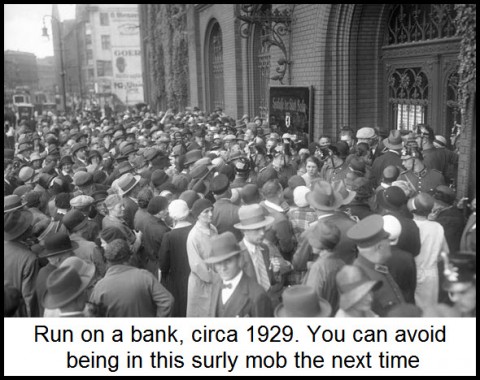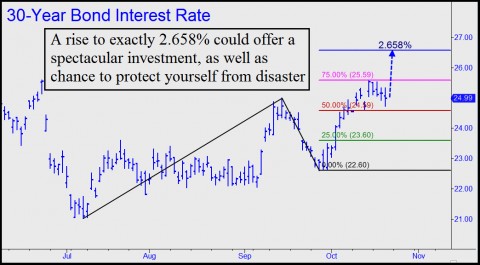[The following was written before a massive cyberattack on Friday knocked out some of the biggest players on the Internet, including Paypal, Spotify, Netflix and Twitter. RA]
 At first, no one even realized the U.S. was under attack. A week before the election, a New York Times reporter poring over Donald Trump’s tax return found a mysterious $5 billion deposit. When the story hit it caused all hell to break loose, politically speaking. The huge deposit was intended as a diversion, and it worked brilliantly.
At first, no one even realized the U.S. was under attack. A week before the election, a New York Times reporter poring over Donald Trump’s tax return found a mysterious $5 billion deposit. When the story hit it caused all hell to break loose, politically speaking. The huge deposit was intended as a diversion, and it worked brilliantly.
The second event, just as peculiar, involved a far larger sum and occurred three days later. But because it concerned the surreptitious transfer of money-market instruments held in an account at the New York Federal Reserve, the seeming glitch was hushed up for nearly two months.
Then, in the first days of the new year, something even more bizarre happened. It got everyone’s attention all right, but the wrong kind of attention. Eighty million Americans received tax refund checks worth between $200 to $600. By the next day, two-thirds of those checks had either been cashed or deposited.
The Treasury Department issued a press release saying there had been an error of some sort, but their request that taxpayers redeposit the funds went largely unheeded. Liquor stores in a dozen large cities reported their biggest single-day surge in sales ever, with Amazon and Walmart close behind.
A blogger at ZeroHedge was the first one to connect up the dots. All of these incidents, he asserted, were related and could only have been the work of terrorists. This theory later proved to be correct, although months removed from ground zero, the attacker’s identity remained unknown.
A Run on U.S. Banks
Of course, it was too late by then to prevent a run on the banks. Customers had started lining up outside the branches of JP Morgan Chase, Wells Fargo, Citigroup and Bank of America just hours after Treasury froze their accounts.
 They would have gone home empty-handed in any case, since local branches seldom hold more than $50,000 in actual cash. This revelation was later to cause riots, although President Obama was credited with calming the nation, at least initially, with a promise that either he or his successor would “get to the bottom of this.”
They would have gone home empty-handed in any case, since local branches seldom hold more than $50,000 in actual cash. This revelation was later to cause riots, although President Obama was credited with calming the nation, at least initially, with a promise that either he or his successor would “get to the bottom of this.”
And that was how a U.S. banking system that had taken more than two centuries to build came suddenly to ruin. Who did it? ISIS, we eventually learned. When they were certain their plot had succeeded – and succeed it did, beyond their wildest dreams — they released a video to the major news networks.
The mastermind was a sinister-looking man named Al-Shishani. Ironically, he was killed in a drone strike in the planning stage and never lived to see what history would record as jihad’s crowning triumph.
In the video, Al-Shishani taunted Americans for greatly underestimating the enemy yet again. As how could we not have? These barbarians were notorious for beheadings, drownings, burnings and, most recently, beating young boys to death with concrete rebar. Who would have suspected that these savages had the brains to hack the Federal Reserve’s most secure digital vault?
 That they had recruited a team of North Koreans and Russians to do the work was beside the point. What mattered was that the destruction they had caused far exceeded that of the 9/11 attack, even though not a single American died.
That they had recruited a team of North Koreans and Russians to do the work was beside the point. What mattered was that the destruction they had caused far exceeded that of the 9/11 attack, even though not a single American died.
If all of this sounds farfetched, you will need to prepare for it anyway, since your very survival could depend on what you do now. Our banking system really is a house of cards, and that makes it an irresistible target for terrorists. It is a sitting duck, as Russian and Chinese hackers have repeatedly demonstrated.
Unfortunately, there is no way the banks can fortify themselves. What’s coming will create problems a hundred times as stressful as the simulations they’ve been running under central-bank supervision.
But that doesn’t mean that we as individuals can’t get ready for the worst by taking some simple steps now, as well as one within the next two months that could produce not only exceptional gains, but bedrock safety for your nest egg.
‘Lifesaver’ Shoe Box
The first step is possible within the next 24 hours: Go to the bank and withdraw enough paper currency to fill a shoe box. Get $1s, $5s, $10s, $20s and $100s – as much as you can afford to sock away.
For make no mistake, you will urgently need this money on the day the branches don’t open. That could happen tomorrow, in a week, or in six months. But it will happen. And when it does, you will be glad you’re not camped outside the doors of some savings institution, waiting desperately, as millions of Americans will be, for the Government to act.
 In the meantime, do not make the potentially fatal mistake of burying your head in the sand. Most Americans are in denial about what’s coming. They are effectively trusting their fate to evil forces that have been hell-bent on the destruction of the West for centuries.
In the meantime, do not make the potentially fatal mistake of burying your head in the sand. Most Americans are in denial about what’s coming. They are effectively trusting their fate to evil forces that have been hell-bent on the destruction of the West for centuries.
Let’s return to the future, so that you might judge for yourself whether this terrible day might indeed be coming.
It was in late September that Al-Shishani decided it was time for ISIS to act. He had been inspired by a 6% drop in the British pound in a single day. News reports of this actual event were unable to specify its cause. A case of trading robots gone awry, or of a fat-fingered keyboard typo?
Whatever the case, the disruption was soon forgotten. Americans receded back into complacency and denial, unwilling to acknowledge the potentially catastrophic logic of what they had seen. The terrorist had seen the news too, and made it the basis of their plan to wreck the U.S. and global economy even more easily than they had destroyed the World Trade Center.
The aftermath of such a financial thunderclap lies almost beyond imagining . It would likely be far worse, even, than the Great Depression. How can we know this? Just follow the money. Nothing could be more deflationary than an unscheduled bank closure lasting more than a few days.
Make no mistake about this. The day the banks fail to open, the misplaced trust and confidence that allow our banking system to function will evaporate in mere hours. That’s because the mostly-digital money system relies on an incredibly complex network of clearing relationships between individual banks and the Federal Reserve. Remove just one small link from that network and it can fall apart.
In a world where stock markets can crash if someone hits a wrong button, the potential for a similar shock to the money system will always be present. That’s why it is all but inevitable that we will awaken some morning to find that our worst financial nightmare has occurred.
Credit Cards Will Fail Us
Could credit cards conceivably tide us over until the worst has passed? Not a chance. As delicate and complex as our money system is, at least some of it exists in the form of physical currency. In contrast, “plastic” money represents a Rube Goldberg machine that links banks, vendors and customers in such a complicated way that not one person in 10,000 could describe what occurs when a charge is made . As such, the system that enables the charge is infinitely susceptible to disruption, compromise and even destruction.
It is therefore difficult imaging stores accepting credit cards once angry customers start lining up outside the banks. And that is why you will need that shoebox filled with paper currency. Think of it as a life raft in a squall.
Some might question this strategy, since it is an irrefutable fact that the dollar is intrinsically worthless. Far from being something with fundamental value, every one of the approximately $1.5 trillion dollars in circulation globally has been encumbered by U.S. debt of more than $20 trillion. “Money” has become debt, plain and simple.
Even so, physical currency will be the coin of the realm on the day the banks lock their doors for an indefinite period of time.
And you can forget about gold and silver, at least initially. Their usefulness in barter will evolve, but at first they will be just…metal. Nor will bullion much circulate, since hoarders will want to save their “best” money for even more-dire emergencies.
The Second Great Depression
What could our Government do about all of this? Absolutely nothing. Even if Uncle Sam could print enough bills to keep the economy from seizing, there would be no quick way to put the money into circulation. A lag of just a few days would be critical in any attempt to reverse the loss of confidence that would occur following an unexpected bank holiday.
Couldn’t the Fed simply order banks to add a few zeroes to everyone’s credit-card limit? Play that forward and you can see how, in a money crisis, sellers of nearly anything would be reluctant to extend credit to shoppers, even for small sums.
We must look beyond day one of the disaster to see how much more difficult life would become when cash is difficult or impossible to come by. The deflationary implosion this will cause will make the 1930s Depression look mild in comparison.
Why is this so?
For one, the nation entered the Depression with a sound dollar that was backed by gold. For two, even though household mortgage and installment debt grew rapidly during the 1920s, it did not remotely approach today’s borrowing for $50,000 cars, million-dollar tract homes, $200,000 college tuitions and the combined liabilities of Social Security, Medicare, public and private pensions.
Here are some other factors that left the America of 1929 in much better shape to weather the adversity of a debt deflation:
- Nearly a third of the working population was tied to agricultural, literally living off the land.
- Just-in-time inventory, requiring Swiss-watch precision to function, had not yet been invented.
- Jobs were not so specialized that the economic contribution of each worker could not be reckoned clearly in dollars. (How much is a programmer at Uber, or a systems analyst at Facebook, really worth?)
- Americans by and large were do-it-yourselfers, able to make and fix things themselves that mostly get thrown out these days when they cease to work.
- Three big industries – automobiles, movies and household electrical appliances — were all shifting into high gear. They were to have a far greater impact on the economy than the likes of Google and Facebook, which, stripped of investor hubris, are just glorified advertising agencies.
No Escaping a Black Hole
We should hold no illusions about escaping the overwhelming force of deflation unscathed when it comes. It will fueled mainly by the collapse of an ethereal, thinly collateralized derivatives market whose notional value has been estimated at close to a quadrillion dollars. The force of the collapse will be irresistible when most of those zeroes are marked to market.
Be aware that this spectacular deleveraging of assets will hold no particular opportunities for investors. That will come well down the road, once the dust has settled in perhaps three to five years. And only investors who have provisioned wisely and without greed will be able to take advantage of them.
When the coming deflation deepens, even financial geniuses like Warren Buffett and George Soros will be challenged to hold onto a fraction of their current net worth. Emulate Buffett’s portfolio, by all means. But realize that he is trying first of all to protect his capital these days, not double it.
We should therefore mimic Buffett’s bedrock strategy to the extent we can. There are no Uber or Twitter shares in his portfolio. Instead, he owns bomb-proof staples of the food chain (Kraft Heinz Co.); railroads and their potentially lucrative rights-of-way (BNSF), and ultra-reliable cash cows like Geico — Would you stiff your auto insurer? — kidney dialysis provider DaVita, and Procter & Gamble. Renowned optimist that he is, Buffett has also given himself some growth potential during the inevitable recovery with significant holdings in Apple, DirecTV, Walmart, construction supplier USG, Goldman Sachs and that time-tested perennial, IBM.
The One Asset You MUST Own
There is one asset you absolutely must own to prepare for the deflationary disaster that’s coming: U.S. Treasury Bonds. Because bond prices move inversely to yields, their value will soar in the event of a global recession-or-worse.
T-Bonds are out of favor now simply because most investors, including some of the biggest names on Wall Street, think yields have bottomed. This is logical, since long-term interest rates have dropped steadily over the last 34 years, from around 15% to a recent, historical low of 2.11%.
How much lower can they go, you might ask? On a percentage basis, they can actually go much lower – to 1.50% quite possibly, or even 0.7%. I have used purely technical means to come up with these projections, and I do not claim to have a crystal ball.
 However, the chart above gives me a very high degree of confidence that the price correction in T-Bonds will bottom with yields at the targeted high of 2.658%. If so, this could offer investors, particularly those for whom safety is paramount, the opportunity of a lifetime.
However, the chart above gives me a very high degree of confidence that the price correction in T-Bonds will bottom with yields at the targeted high of 2.658%. If so, this could offer investors, particularly those for whom safety is paramount, the opportunity of a lifetime.
Besides benefiting from a deflationary trend and global recession, the Bonds also have the potential for a spectacular rally. This would occur if investors around the world, roiled by a severe financial crisis, flee to the perceived safety of dollar-denominated assets, particularly Treasury Bonds.
To verify my prediction, watch for yields to rise over the next several months to exactly 2.658%. If they do and there is a decisive pullback from that number, it would confirm my forecast of a renewed bull market in Treasury Bonds.
Capital gains could be as high as 25% if T-Bond yields were to fall to 1.50% over the next 18 months. That’s because the further you go out on the yield curve, the more leveraged bond price movement is to small fluctuations in interest rates.
Ask your broker for assistance in this, since there are numerous ways to play a drop in long-term yields. They include purchasing zero-coupons, muni “strips” or even an equity-based vehicle that trades on the NASDAQ Index with the symbol TLT.

Thank you for this article!